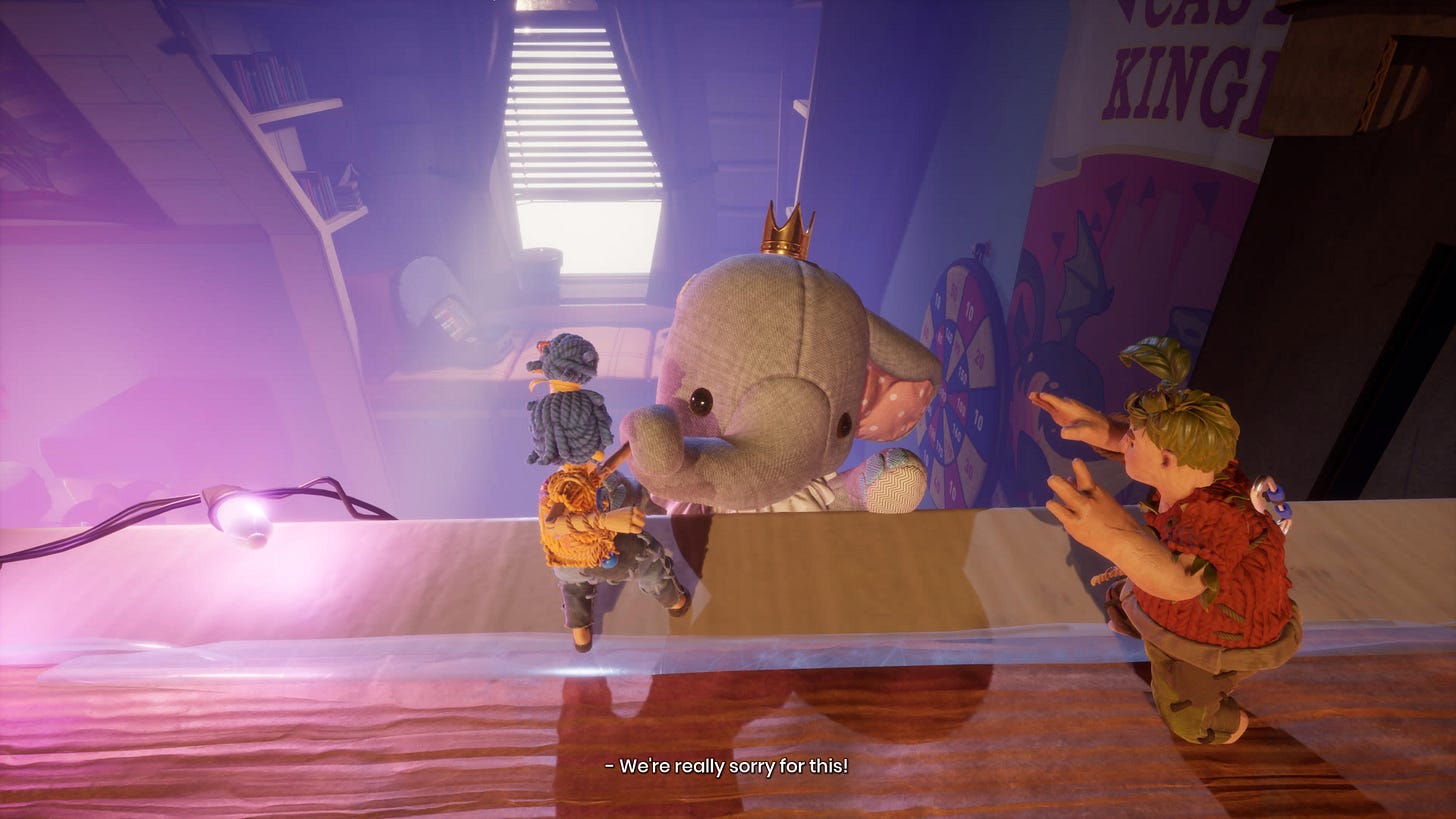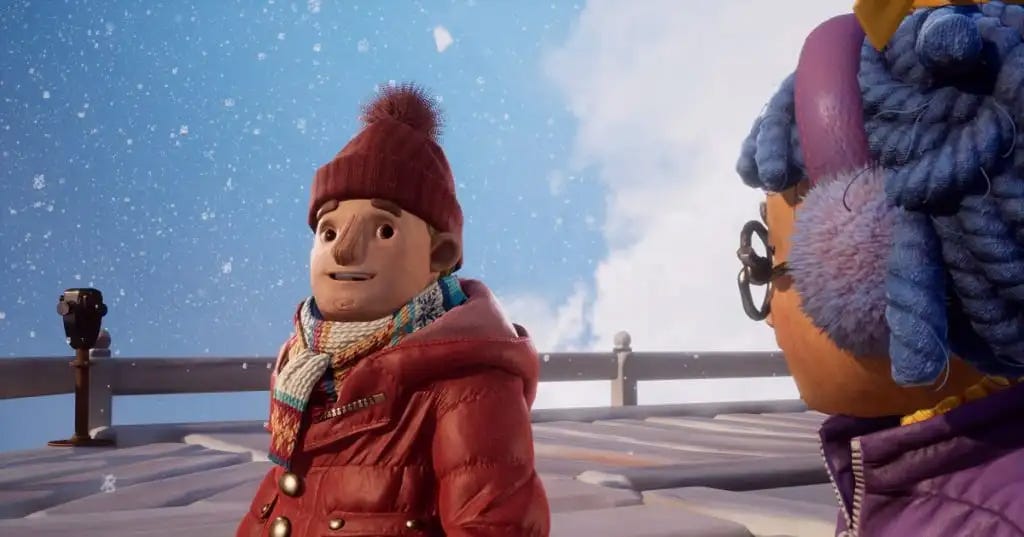It Takes Two: Pt. 1 Intro & Storytelling
A winning couch co-op formula regales us of an unexpectedly moving love story to make for one of the best and most memorable gaming experiences of the past several years.
As the family that games together stays together, my partner and I are always looking for games that we can play cooperatively. That’s why we’re huge fans of Hazelight Studios, the makers of It Takes Two, as they’ve essentially cornered the market on games that must be played in two-player co-op.1
The studios’ first two offerings received some acclaim, largely because of how they innovated multiplayer gameplay, but It Takes Two was a noticeable step up in class — with improved and more varied gameplay (utilizing more fun and whimsical platforming mechanics), a massively upgraded graphical presentation, and (as we’ll talk first and at length about in this chapter) a story and characters that rise above some missteps in the early hours of the game to tell a gripping tale.
These improvements are what earned this entry from Hazelight Game of the Year honors at the 2021 Game Awards and elevated it to a truly immersive experience.
Storytelling
As I talked about in this blook’s introduction, story comes last for a lot of games — I’m pretty sure this was the case for Hazelight in the making of It Takes Two. And this is fine! If a game is only going to achieve excellence in two of these three categories, gameplay and aesthetics are more important than telling a compelling story (though this is usually what separates pretty good games from great, immersive experiences).
For the first half or more of my time with It Takes Two, I thought it was going to come up short of achieving high marks in storytelling, as I was having major issues with both the plot and characters for the first 7-8 hours of the campaign. Before talking about what didn’t work for me, here’s a quick summary of the plot:
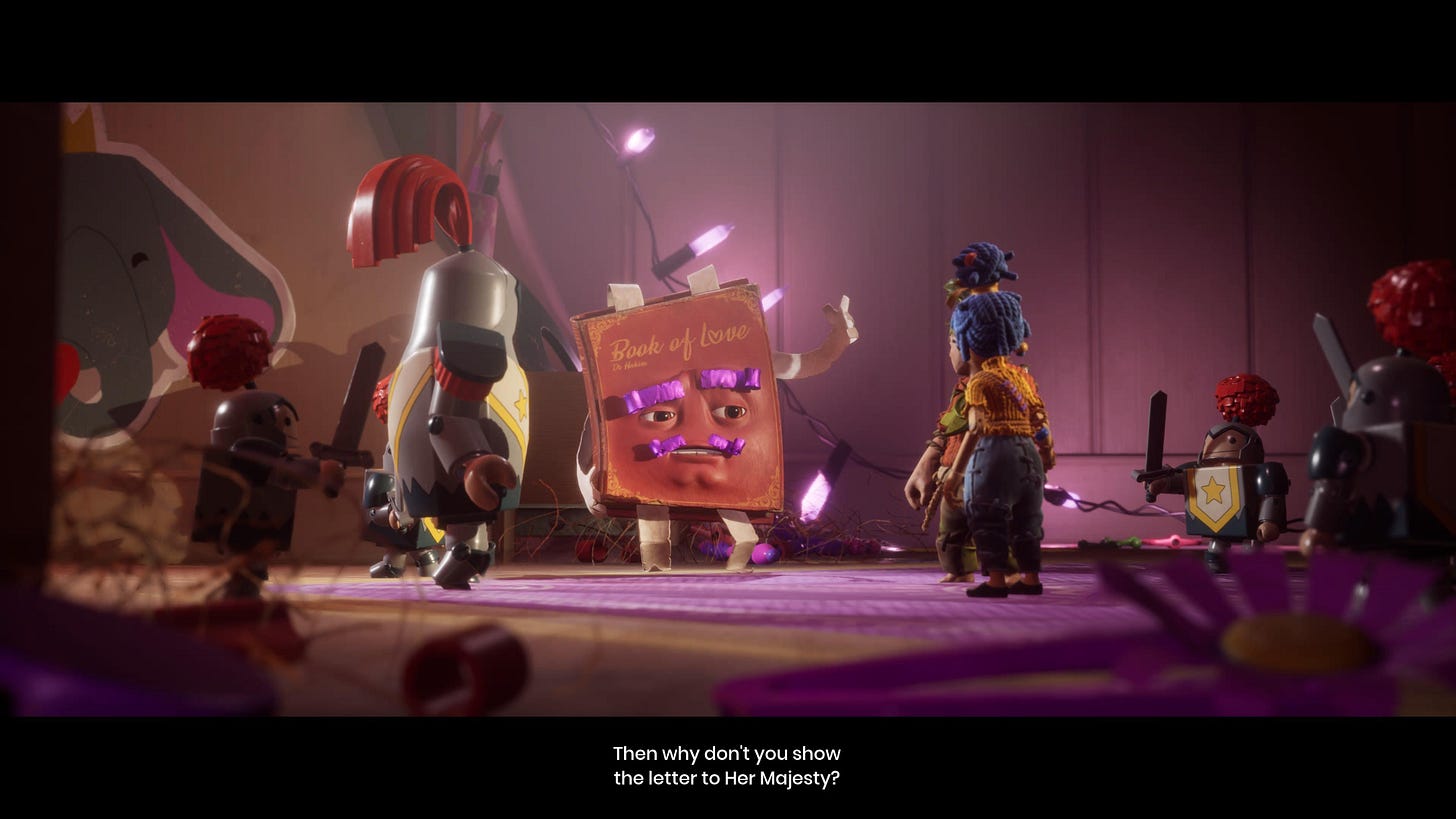
Married couple Cody and May have fallen out of love and are planning to divorce. Their daughter, Rose, takes dolls she made of her parents out to the family’s shed to play-act them fixing their relationship — an effort Cody and May have no interest in. When Rose sheds tears on the dolls, real-life Cody and May fall into a deep slumber and awaken in doll form inside the shed.
They’re greeted by Dr. Hakim, a relationship guru embodying a magical version of “Book of Love,” his relationship therapy guide, which Rose found at school (apparently in the trash?!) and brought home in an attempt to save her parents’ marriage. Dr. Hakim proceeds to guide Cody and May on an adventure to save their relationship, which the couple vehemently objects to, yet are spurred on by their desire to find a way to get back into human form so they can continue with their separation.
Through trials that are (either very loosely or ham-fistedly, usually to comedic effect) tailored to be metaphors for fixing their relationship (e.g., making “time” for each other by repairing a giant clock tower using abilities that literally change the flow of time, bringing “sweetness” back into the relationship by fixing a candy-cane fracking operation), Dr. Hakim forces Cody and May to rely on and work with each other to overcome each of the obstacles he sets in their way, while ultimately reminding them of what made them fall in love in the first place.
Josef Fares described this game as a romantic-comedy, and I will give him credit that I did have laugh-out-loud moments through the early part of the game when the larger plot hadn’t quite started clicking yet. Dr. Hakim’s amusement with the misery he puts Cody and May through in a Saw-esque type of forced relationship therapy never failed to make me chuckle (even while I found his Latino Love Guru schtick a little annoying).
Perhaps the couple’s torment amused me because for the game’s opening hours, I couldn’t stand either of the protagonists. Both of them come off as so self-absorbed and aloof that my early impression of their relationship was that a divorce was definitely the best thing for them because neither of them was deserving of love. Part of this was, I’m sure, intentional within the game’s script, but what added to it was just how annoying both characters are when you’re trying to play the game itself.
It Takes Two is such a beautiful game with so much to find and explore in each level, that you want to stop and smell the roses from time to time. And yet, you’re sometimes discouraged from trying to interact because when your partner starts to move toward the next objective (intentionally or not), it prompts their character to beckon you to move it along (“Come on, Cody!”). I thought the only immersive experience I was going to get from the story and characters was when May and Angela (my Player 2 in games and in life) were nagging me in unison about taking too long to catch up. (That was a joke, she told me to write this.)
There’s a moment from It Takes Two’s fourth level that is maybe my least favorite sequence from any game I’ve ever played:2
With no clear instruction on how they can get back into their human forms, Cody theorizes that recreating the circumstances in which they turned into dolls — making their daughter cry — will reverse the curse. After flying on a paper plane into Rose’s bedroom, they realize their daughter can’t see them while in doll form, but she does notice when they interact with certain objects in the real world.
Cody and May spot Cutie (a plush elephant who is Rose’s favorite toy) standing atop the doll castle, which Cody had built and of which Rose had anointed Cutie queen. To force their daughter to cry (which the couple doesn’t really see anything wrong with), Cody and May hatch a plan to infiltrate the castle and push Cutie off its walls, causing her to plummet to her death, which they assume Rose will see.
This premise is already pretty unhinged, given Cody and May have no evidence that their scheme to turn back into human form by getting their daughter to cry will work (spoiler: it doesn’t). That makes it all the more upsetting when you finally meet Cutie, find out she’s a delightful and benevolent ruler, threaten to kill her (much to her dismay), and are forced to systematically rip off the elephant’s limbs and trunk before hurling her from the castle.
To me, this is storytelling and game design at its worst. The player knows that what they’re being forced to do is morally incorrect and likely will be pointless in the end (this happens early in the game when Cody and May’s relationship is still very much on the rocks and the plot is nowhere near a resolution). Yet, “forced” is exactly what the game does to get you to partake in this cruel act. There’s no other, more clever way to handle the situation, or to even decide that you don’t want to go through with it at all. The options are to stand there and watch while Cutie struggles in perpetuity, turn off the system and refuse to proceed, or opt into a brutal massacre of a very cute anthropomorphic plush elephant to continue the game.
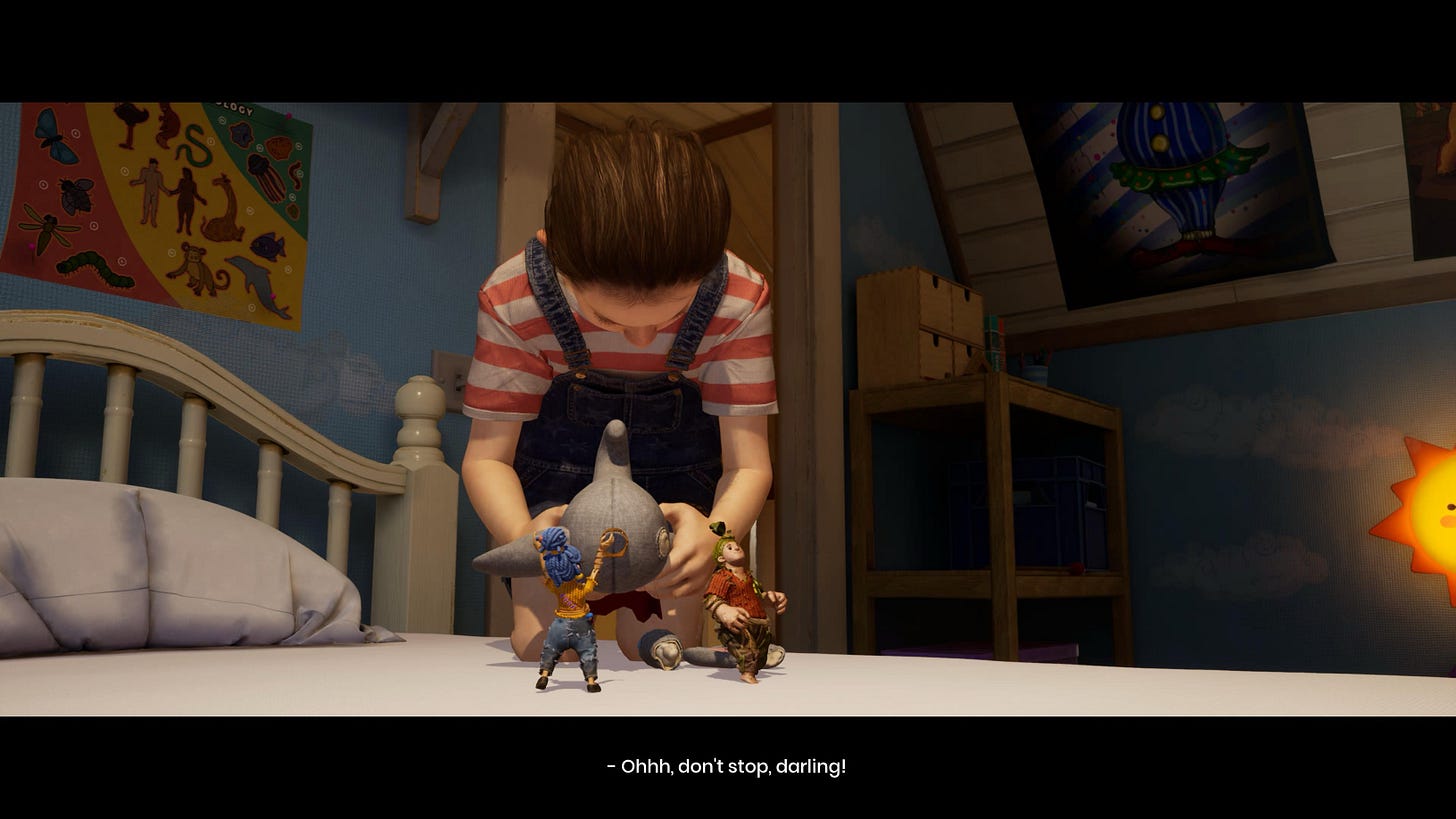
When Cutie hits the floor and Rose sees her favorite toy ripped apart, she cries, just like her parents had hoped, and they dance around in her stream of tears. And then nothing happens. The entire ordeal was quite literally for nothing. All that happens is Cody and May find a note from Rose3, which Dr. Hakim splits into four parts to set up the game’s final four levels.
I get the point of this sequence in the game — we’re supposed to understand that Cody and May are so selfishly absorbed in their own problems that they’re failing to consider or account for the impact their actions will have on the others around them (in this case, their daughter).
Maybe it’s because this was my second playthrough of the game when I really mulled over the weight of this moment, but I felt like this was something I already knew about the characters at this point (Rose’s scenes attempting to talk to her parents who she thinks are either asleep or are just ignoring her, which doesn’t really phase her, already did the job), and didn’t need it so heavy-handedly explained to me. Especially because it featured a sequence where I was forced to control my character to commit a murder I did not endorse, and there was no way to circumvent this action. The whole thing felt unearned and left a sour taste in my mouth.4
At this point, I doubted the story for this game would ever click with me — A Way Out featured a similarly questionable and controversial sequence at the end of the game, which left me with mixed feelings about the title as a whole when the credits rolled.5 And given that experience, I didn’t trust that the writers at Hazelight were capable of redeeming two characters I now felt were monstrous.
I wasn’t familiar with their game.
Here’s what happens two levels later:
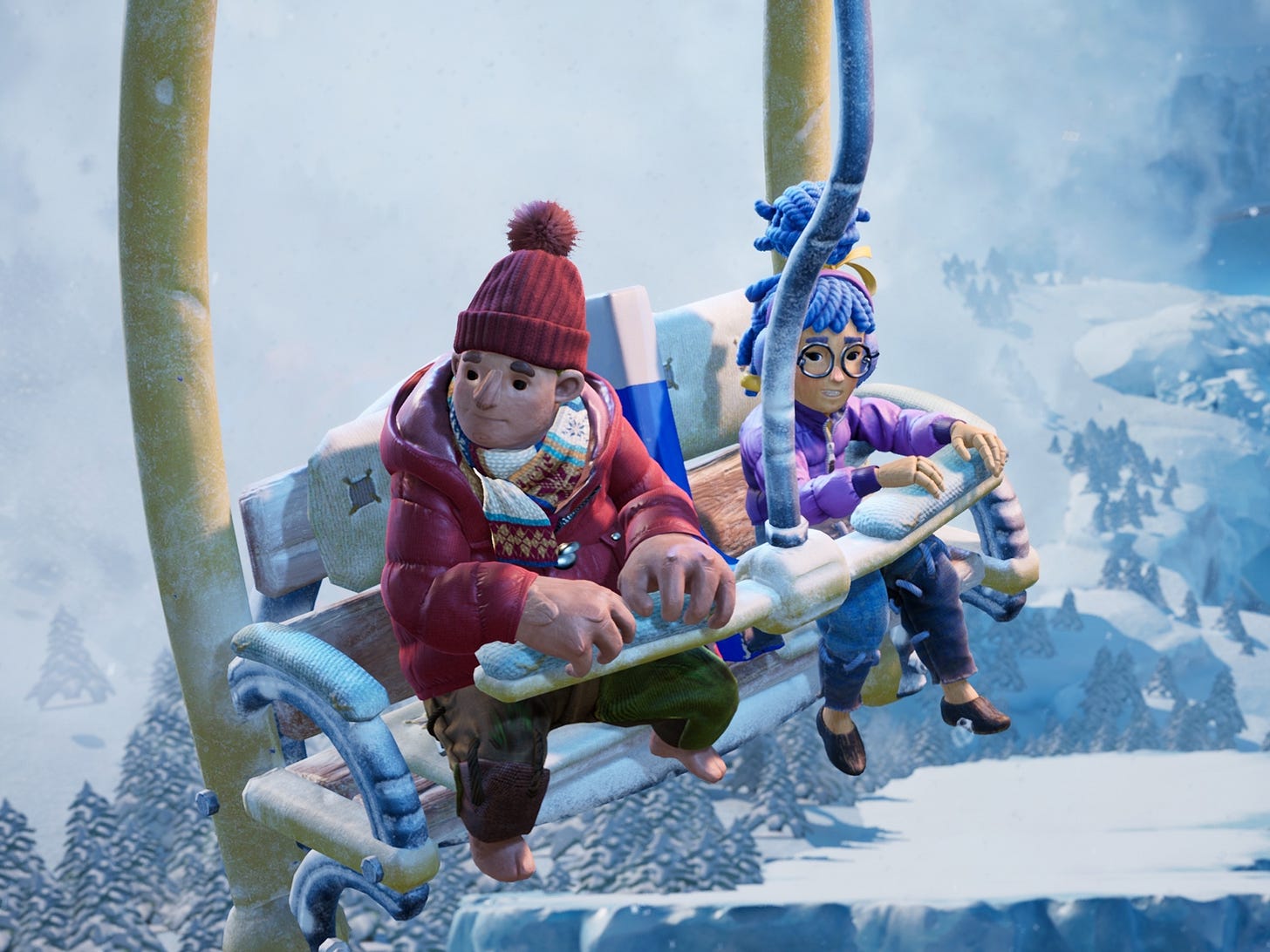
Cody and May visit a winter wonderland (inside the snowglobe in their hallway) that is a replica of the mountain town in which they took their last vacation together — just before Rose was born. At Dr. Hakim’s instruction (with the promised reward of the second piece of Rose’s letter), they journey to the summit of the mountain.
Along the way, they earn a break to chat as they take a ski lift up part of the mountain. They discuss why they haven’t been on a vacation since Rose was born, coming to the conclusion that money has been far too tight to afford any sort of significant time away from home.
May suggests that after they sell the house, there should be some money left over for Cody to take Rose on a weekend trip to a water park, then May can do the same with her later when she has time. “Double the fun,” May says, which Cody slowly repeats and stares off into the distance. His feelings about their relationship have started to change but May’s haven’t, and this devastates him.
Later, when the two finally reach the top of the mountain, it’s revealed that this is the spot where Cody proposed to May. He reminisces about how nervous he was and calls it “the worst proposal of all time.” May disagrees with him, and says it wasn’t the words that mattered, but rather that it was brave of him to be vulnerable and show just how scared he was. Cody shows the same vulnerability in this moment as well, and May offers warmth and kindness in return. It’s a depth we hadn’t seen from either of them up until this point, and confirms that, despite their griping and bickering for the story’s first 10 hours, they do in fact have the ability (and willingness) to fix their relationship.
They stare at each other as snow delicately falls, unsure of what to do next. And of course, Dr. Hakim appears, singing, with a shit-eating grin.
This moment of comic relief choked me with laughter and made me quickly wipe away the mist that was building up in my eyes.
I said I picked the first three games in this book because they formed a lot of my theory and opinions about what immersion in games means, and the elements required to create that feeling. While gameplay and aesthetics are the two most important aspects of making a game that is good, becoming truly immersed in a game requires a connection to the characters and trials they’re going through.
Before this moment at the summit of the mountain, I was enjoying my time with It Takes Two. (I downloaded it the same day it hit Playstation Plus for a second playthrough less than a year after we played it on the Switch). But it wasn’t until Cody and May dropped their cold, sarcastic fronts and became open and vulnerable with each other that the game fully brought me into its world.
This was an unexpected masterclass in storytelling. It revealed that Cody and May were locked in a game of relationship chicken. That the problems they’d been experiencing (not making time for each other, not communicating, and failing to empower, encourage, and support one another) were possible to overcome. But, as Dr. Hakim continued to needle, this would require them to meet each other in the middle — to be honest with each other and reveal that the parts of them that had caused them to fall in love in the first place were still there.
The time and effort it takes for the characters to realize this makes it all the more sweet when it finally pays off. Like I said, halfway through this game, I had serious doubts about the writers’ ability to make a satisfying and believable resolution for the characters they’d established. I couldn’t have been happier to be proven wrong.
It Takes Two’s last two levels feel less emotionally consequential than the mountain summit scene. Cody and May learn to support each other in their passions (gardening and singing, respectively), while also not blaming their partner for not following through on them. But at this point, the story had gotten me invested in the characters and I was fully immersed in the game, happy to spend a few more hours with Cody and May feeling confident their love story would be a happy one.
In It Takes Two’s final playable moment, you and your playing partner each hold a button to make Cody and May kiss for the first time6, and, unlike the sequence with Cutie I described earlier, this feels earned and emotionally satisfying.
Click here to keep reading about It Takes Two
It Takes Two, 2018’s A Way Out, and the soon-to-release Split Fiction all must be played like this. The studio’s first game, Brothers: A Tale of Two Sons, could be played in co-op or single-player, where you control both of the game’s characters at the same time using one controller.
A friend recently informed me this may be an homage to an OG God of War game. I’m not sure if that makes it any better.
We later find out the note is Rose telling her parents that she’s running away from home on the next bus out of town, which, honestly, is a great call.
There are cases of something like this being done effectively — where you are forced to make a character do something you don’t personally agree with, but you can at least understand their motivations for doing it, and the action serves as an important plot and/or character development point. I’ll talk about this more when we get to The Last of Us Part II.
I won’t spoil that twist here. I still recommend you try A Way Out if you liked It Takes Two, and there’s plenty of discourse about it online if you want to seek it out.
I played this game with someone I’ve been in a relationship with for almost 12 years and it felt heartwarming, but it did make me wonder how people playing with a platonic friend, sibling, or family member felt when they had to hold down the triangle button for 10 seconds to make out with their playing partner in order to beat the game. Talk about one hell of a final boss.

